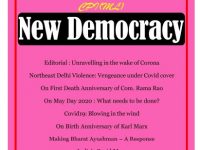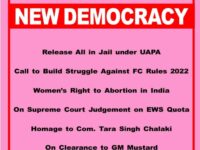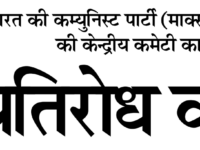S.S. Mahil
A valiant peasant struggle is surging in Punjab. This struggle started with the Central Government of fascist RSS issuing three Ordinances which were passed by parliament in its monsoon session this year. In the Lok Sabha BJP has a clear majority but it lacks one in Rajya Sabha. However, bulldozing the majority opinion against Bills, those were passed by voice vote. President of India readily and speedily granted his assent. Thus these Bills, first issued as ordinances, were made law with a lightning speed. Why was government of India in such a hurry to enact these laws? Government was acting under the direction of two authorities, was working under their pressure. One was the pressure of World Trade organization which came into existence on April 25, 1994 by signing a treaty at Mrakesh and which is popularly known as Mrakesh treaty, by Indian government led by Narsimha Rao of Congress and Dr. Manmohan Singh as his game changer finance minister. This treaty provides that to facilitate free trade and open market, assistance provided to agriculture by government in any form, be it subsidy or any other form, shall cease. It also provides that governments shall stay away from agriculture trade except for the sake of food security. At that time there was a serious debate on this treaty, particularly in Punjab. Captain Amrinder Singh was one politician who openly supported this Treaty. He wrote an article in Punjabi Tribune supporting world Trade Organization. Now Congress party is taking a posture of opposing these anti people Acts and its state governments in Punjab, Rajasthan and Chhattisgarh have passed resolution and parallel Acts rejecting the acts of central governments but the matter of fact is that it is Congress who is primarily responsible for these policies and consequently for these acts. World Trade Organization in its meeting held in 2013 gave five years to abolish government procurement of agricultural produce and all agriculture related subsidies by December 2018. US government had gone to dispute settlement mechanism against India for continuing “free trade distorting subsidies”. So this was the pressure on Indian government to pass these acts to ward off the US pressure, whose dictates Indian government is faithfully following and also to avoid the action by dispute settlement body of WTO. Second, world capitalist system is in a serious crisis which is essentially crisis of demand. Present crisis which set in since 2008 is continuing to deepen and corporate is unable to find a solution of this crisis. So international and Indian corporate are trying to bring the agrarian sector under its control. Corporate pressure was the other factor to force these acts.
This is not something dropped from the sky. Indian ruling classes are trying to implement these policies since mid nineties and Dr. Manmohan Singh is (dis)credited with these policies. He appointed an expert committee headed by Dr. Sardara Singh Johal to prepare a report for “making Indian agriculture competitive in the era of globalization.” Essence of the report submitted by this committee was that small farmers must be ejected from Agriculture and large farms of thousands of acres should be created to make India agriculture competitive. One proposal was to establish a land market on the lines of share market and other was to abolish government procurement of agriculture produce. It made another proposal to introduce contract farming. But this report could not be implemented because of political compulsions and people’s resistance. Amrinder Singh during his first stint as Chief Minister appointed an expert committee headed by same Sardara Singh Johal and which, among others, made a proposal to open private markets alongwith government markets. During Modi 1, Union government appointed a committee headed by Sh. Shanta Kumar, a Minister in Vajpayee cabinet, which gave its report, proposing downsizing (virtually abolishing) Food Corporation of India, and stop purchasing agri produce beyond food security needs.
According to a Peasant leader of Punjab, in 2017 Neeti Aayog called a high-level meeting which was attended by nearly 150 persons including government officials, agriculture and economic experts, representatives of corporate and three farmers’ leaders, including this one. Government officials presented the issue that growth in agriculture sector is stagnant rather going down, how to accelerate growth in agriculture was the agenda and issue before the meeting. Experts were invited to give their opinion. They opined that this sector needs large investments which farmers are not in a position to undertake, hence the corporate should come forward to invest in this sector. Corporate are ready to invest but government should provide them farms of ten thousand acres and peasants shall not interfere, they may work on the field but only as wage labour. According to this leader, he warned them that this will result in a massive social upheaval. Now this policy is being implemented through these Acts.
So a consistent effort is on by both main ruling class parties to implement WTO and corporate dictated terms on agriculture. Sanghi fascist government, blinded by its bulldozing majority in Lok Sabha and using the artificially created corona scare and fascist restrictions imposed in the name of corona, has fully implemented this imperialist dictated policy throwing the farmers before the corporate wolves. Act on contract farming facilitates the entry of corporate in this sector. Act on marketing of agriculture produce facilitate corporate in agri-trade and, by removing the assured price by government withdrawing from procurement, will force the peasant out.
Present struggle started from below. First, district level protests against these Ordinances were held by individual organizations in month of July, immediately after the promulgation of the Ordinances. Then, constituents of AIKSCC held five big rallies at Moga, Barnala, Patiala, Phagwara and Amritsar. BKU (Ugrahan group) held Dharnas at Patiala and Badal village. AIKSCC constituents gave a call for Punjab bandh and appealed to other farmers organizations to come together to fight out these ordinances. Meanwhile some factions of BKU and some local organizations came together to form a platform of 13 organizations and they decided to support the bandh call. A meeting of all organizations working in Punjab was held at Moga at the initiative of AIKSCC, attended by all organizations and a joint platform of 30 organizations was formed but Ugrahan group later stated that they will have only coordinated action but not be a part of this platform. Punjab bandh on 25th Sept. was unprecedented and complete. All sections of population not only supported but actively participated in this Bandh. This gave a big boost to the struggle. After this, the joint platform decided to block rail traffic indefinitely, gherao the offices of Bhartiya Janata Party and the houses of their leaders, business of Ambani and Adani and toll plazas. Dharnas are going on at nearly 150 places in Punjab. This struggle is directed against BJP government, BJP party and corporate, particularly against Ambani and Adani.
This is the third largest mobilization since the land struggle of PEPSU tenant peasants in late forties and early fifties of last century. First was the struggle against the “betterment levy” imposed by Pratap Singh Kairon, then Chief Minister of Punjab. This was a struggle led by Kisan Sabha in 1959 in the form of Jail Bharo. Such was the sway of the movement, Akali workers at local level were forced to join with their yellow flags. Thousands were jailed and fines imposed. Police tried recovery by confiscating their property. People resisted and clash with police took place. Police resorted to firing and lathi charge. Two peasants were killed and hundreds were injured. The second largest mobilization was 1983 -1984 under the leadership of BKU in Malwa region and under the leadership of KKU in Majha and Doaba regions. This started with issues related to electricity but included all most all issues regarding owner peasantry. This is the third largest mobilization since 1947 which, though it is on peasants’ issues, but whole Punjab, except the city section of BJP, is supporting this struggle.
Why do we call it is a struggle of Punjab and not simply of farmers only? First, Punjab is already facing a problem of high unemployment because (1) The over mechanization in agriculture has reduced the scope of employment in this sector (2) Punjab is industrially a backward state rather, it has witnessed the phenomenon of de-industrialization particularly since the period of Khalistani movement and concessions being given to the neighbouring hill states and (3) Migrant labour from other states has flooded the labour market. With the implementation of these laws, the whole marketing apparatus will be mechanized with the advent of Corporate in this field. So whatever employment is there, will also be finished. Secondly with corporate capturing Agriculture, large farms will come into existence which will be wholly mechanized. Thus, employment still available in certain operations of agriculture will be finished and with this phenomenon, peasants employed will be pushed into the army of unemployed. Apart from this, with the withdrawal of government from procurement of agriculture produce and removal of stock limit, traders will be free to hoard the stock and artificially raise prices, which will affect the whole population. When there will be no government procurement, public distribution system will be thrown to the winds. Lastly Punjab is an agricultural state, agriculture is the mainstay of the economy of this state. Whatever affects agriculture is bound to affect the whole state. That is why it is not a struggle of peasants alone but the struggle for Punjab.
Why are mainly peasants of Punjab mobilized on such a scale compared to other states? Some people say that government procurement is on mainly in Punjab, Haryana and parts of west Uttar Pradesh. This is not the main reason, because such large-scale mobilization has not taken place in Haryana and west Uttar Pradesh. Moreover, it is not simply a question of minimum support price and government procurement, though this is also one issue. Act on contract farming is more dangerous from the peasant point of view. The very existence of this class is in danger with the entry of Corporate in Agriculture. After Modi’s assent to power for the second time in 2019, the Central govt. vigorously unleashed fascist offensive against the people for which it has prepared the ground in its earlier stint in power from 2014-2019. In first phase, offensive was mainly political i.e. on political issues like removing special status and dismemberment of Jammu & Kashmir, criminalizing triple talaq, manipulating by carrot and stick, Supreme Court decision on Babri Masjid, which is a shame in the judicial history and bringing Citizen Amendment Act and National Register of Citizens. Struggle against this offensive on political issues was going on when came Corona. Corona could have been prevented by banning the entry of all foreigners and compulsory quarantining of Indians coming from abroad. But government did not take these steps because it wanted corona to spread. On the other hand Government spread the unnecessary scare of corona. Using corona as a weapon for fascist offensive government locked the whole country in the homes. Punjab Chief Minister, going a step further, imposed curfew.
In Punjab we tried to understand the nature and different aspects of this disease during the first lockdown period. We tried to understand and educate our cadres about difference between with required care about elderly and sick and the scare being created by the Govt. During second lockdown ZPSC and Pendu Mazdoor Union gave a call to protest in the villages, in the streets, in front of houses. This was to gauge the mood of the masses. We came to the conclusion that the scare is largely in the urban areas especially middle class but rural poor are largely free from it. Front of eight political parties and organizations formed at the initiative of CPI (M-L) ND gave a call for protests and pay homage to the martyrs on 13th April and also to celebrate May Day. We did mass mobilization on May First in rural areas. Then we decided to break curfew, mobilize masses on their burning issues and without following the government guidelines issued by Centre and State governments. We educated the ranks on Corona that what is the disease and what is the scare. First large-scale mobilization took place in Bhawanigarh town of Sangur on 15th May where hundreds of workers marched two kilometers to a factory gate without any distancing and without wearing any masks, led by ZPSC. On 22 May five hundred people came on the roads without any precautions, breaking curfew and led by Indian Federation of Trade Unions. This was on the issue of relief for the workers and arranging return journey of migrant labour. Demands were met but case was registered against two hundred people. In June, Comrade Nirbhay Singh Dhudike was arrested along with youth and student leaders fighting against the displacement of fish market in Moga and was put behind bars. To protest against the arrest and demanding release of comrades a state level protest demonstration was organized by KKU in Moga mobilizing three thousand people. After this many mass mobilizations took place. Nearly 1700 cases were registered against leaders and activists of mass and party mass organizations, but without bothering about the cases and jails, mass mobilization continued without fear. Thus scare of corona and government restrictions was thrown into the wind. Then all other parties and organizations started mass mobilization and state government had to reconcile with this trend. This laid the ground for such a large surge of the peasant struggle.
People of Punjab, being in lead in this struggle and in multifaceted attack on union government, ruling party and corporate, have had to pay the price. Union government has created a situation of confrontation and encirclement of Punjab. Modi government has not released the state’s share of GST, it has blocked the rural development fund on the flimsy ground of Punjab government not furnishing the accounts of its expenditure. Though central government is entitled to ask for accounts but it is not entitled to block the funds on this ground. This is completely illegal and unethical. Because of the rail blockade by peasant organizations arose a situation of scarcity of essential goods, specially coal and fertilizer, resulting in constraints on supply of fertilizers for sowing of wheat and potato and large cuts in electricity supply. It also created the problem of lifting of paddy purchased. It was also affecting industry in supply of raw material and lifting of finished goods. Seeing this, farmers’ organizations decided to allow the plying of goods trains, vacated the railway tracks and shifted Dharnas to railway stations. But Railway Board refused to run the goods train on the plea that large number of people on the platform is a security risk. Then organizations vacated the platforms too and shifted dharna to the parks in front of railway stations. But Modi government refused to run the trains unless passenger trains are allowed. Now peasants’ organizations have allowed the running of both types of trains. But it reflects the anti Punjab and venomous attitude of Modi government. Modi government issued an Ordinance providing fine of one crore rupees and five years in jail for stubble burning, this is obviously to penalize the struggling peasantry. RBI has decided to waive certain type of interests for overdue loans. But next day RBI held a special press conference to announce that this facility will not be available for the farmers. This is nothing but revengeful attitude of fascist Modi government.
Fascist Central government targeting Punjab is not only because of present farmers struggle. Punjab has emerged as a hub of mass resistance against fascist offensive. When fascists attacked Jammu & Kashmir by robbing it of its special status, dismembering it and downgrading the state to two union territories, a front consisting of eight parties and political organizations was formed against offensive on Kashmiri people. Massive protests were held by this front and mass organizations. Such massive protest did not occur in any other part of the country. Massive and continuous protests were held against CAA and NRC till the lockdown was imposed. Then mass protests started defying the curfew. So fascists think that Punjab is in front of resistance to their fascist offensive and they want to suppress it.
With this has emerged the issue of centre-state relation and attack on federalism or what little of it exists. Added to the people struggle, Punjab Assembly, in a special session passed a resolution rejecting three Acts and formulating its own Acts. This was followed by Rajasthan and Chhattisgarh Assemblies doing the same. MLAs from Punjab led by the Chief Minister and barring Akali Dal and APP, staged a dharna at Jantar Mantar in Delhi demanding running of goods trains, release of GST dues and Rural Development Fund. Chief Minister requested for a meeting with President of India, which was refused. This has pitted the Punjab government and Union government against each other, reflecting the Centre state contradiction. CPI (M-L) ND held a state level convention on “Encirclement of Punjab and Centralization of powers”. Fascism entails concentration of power, so attack on federalism, whatever little exists, has emerged as an issue. Constitution of India is essentially unitary with some federal elements, now even that is under attack. As Agriculture is a state subject according to the Constitution, the Centre is not entitled to enact any law, but the Centre has enacted these three Acts on Agriculture, which is a violation of “federal structure” provided in the Constitution. So the present peasant struggle has this aspect too.
This is struggle of farmers but has support among entire cross sections of Punjab. Whole political class is in support of this struggle. Congress has openly taken a stand in support of the struggle. Initially, Akali Dal tried to support the bills saying that Congress is misleading the farmers whereas bills are in favour of peasantry. Its President, Sukhbir Singh Badal, brought a letter from Union Agriculture Minister, N. S. Tomar, to show that Union Government is committed to continue minimum support price mechanism. Seeing that their standpoint is further isolating their party among the peasantry, Akali Dal changed its stand and its lone Minister in Union Cabinet, Harsimrat Kaur Badal, resigned from the Cabinet and Akali Dal was forced to walk out of the National democratic Alliance (NDA) and was forced to support the agitation. AAP is also taking the position of opposing these Acts but both these parties, Akali Dal and AAP, are directing their fire against the state government of Congress party instead of directing it against Modi and his government. All these parties are trying to use this agitation for capturing power in Chandigarh in 2022 elections. As far as BJP is concerned it has divided approach. Leaders based in rural areas, though not opposing the Acts and supporting agitation directly, are positive towards farmers and urging the farmers and the government to sit at the table and try to solve the issue through talks. They were instrumental in arranging meeting between peasants’ organizations and the government. But the main leaders of BJP, based in cities, are dead against the struggle and are spitting venom against the struggle. It is branding peasants’ leaders as middlemen and urban Naxals. Similar is the attitude of All India leadership and government of BJP. Modi himself, during his election campaign in Bihar, has been branding the struggle as the agitation of middle men, and declaring loud that these Acts and decision on Jammu Kashmir will never be rescinded thus comparing this agitation with struggle of Kashmiri people.
But people of Punjab are with the struggle. Industry associations in different cities and their Punjab body have declared open support to the struggle. State Vyapari Mandal and that in different cities have come out in support. Various organizations of transporters have pledged support in all forms including free supply of vehicles. Actors, Directors and other artists of Punjabi films have been continuously participating in dharnas and singers perform in dharnas. Punjabi music, was promoting gangs, gang wars, weapons, drugs etc. but now songs on exploitation of peasants and repression on them are in currency. Those people who are unable to participate in struggle directly, are contributing in different ways in form of logistics as atta, dal, milk and other food materials, sound systems, tents and funds etc. It is a real people’s movement.
People are determined to fight to finish. Peasants feel their very existence is in danger. But organization is the weapon of struggle. Unorganized masses cannot achieve the goal. This struggle is under multiple class leadership. It includes the representatives of poor peasants, middle peasants, rich farmers and even landlords. There are some leaders who have nothing to do with peasants or farmers, their main concern is to highlight that they are in command. Main leadership is of middle peasants and poor peasants and rich farmers are in minority. Feeling that this movement cannot achieve its goal without mobilizing peasants on all India level, efforts were made to unite organizations active in different states. But result of these efforts has been that rich farmers and landlords have taken the lead. This is not a very favourable situation for the struggle. Rich farmers are always prone to a half way compromise and middle farmers mostly tend to follow these rich farmers. Organizations representing the interests of poor and small peasants are a small section. So a danger of half way compromise is looming large. Hence a very sharp struggle is on the card. Revolutionary forces in this struggle have to remain very vigilant. They should base themselves on two things. One, people want to fight to the finish and secondly, they want this fight to be unitedly fought. So revolutionary forces in this struggle should never be seen as breaking unity, being against unity and violating it. Secondly, they should never be seen as not willing to fight till end, should be unwavering and always ready to take risk for struggle. This struggle has to be carried forward very deftly and wisely. Motto should be to fight to win.



